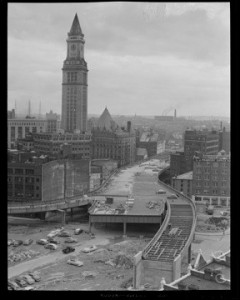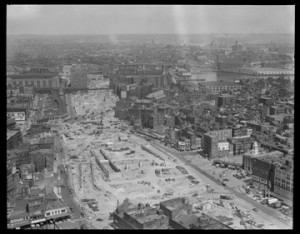Who Shaped Boston’s Central Artery and Big Dig?
-
-
slice.mit.edu
- 1
Filed Under
Recommended

In the 1950s, many MIT alumni, professors, and students helped design the elevated Central Artery, Boston’s first modern highway that sliced through downtown. However, only two—Cranston (Chan) Rogers SM ’50 and Fred Salvucci ’61, SM ’62—are known to have played major roles in the Big Dig project 40 years later that relocated the expressway underground and dismantled the elevated Central Artery. This story describes Rogers’ contribution.
Laying out the elevated highway meant demolishing more than a thousand buildings and uprooting some 20,000 people from homes and businesses. As the green-painted highway forced its way through downtown, Rogers recalled public protests about so much destruction for such an ugly road.
“Commissioner (and later governor) John Volpe suggested putting the next segment by South Station underground and asked me to estimate what it would cost,” said Rogers, who was project manager for finding an alternate route for that section.
Rogers estimated that a tunnel would cost about $18 million or double the cost of an equivalent elevated structure. When Rogers reported the cost differential, Volpe said yes.

The Dewey Square Tunnel ran about 3,800 feet with about 2,800 feet underground. It was the only part of the national highway system to be put underground at that time (1956) and was also the widest vehicular tunnel in the world.
Eventually, traffic clogged the new expressway. The proposed solution, dubbed the Big Dig, involved demolishing the entire elevated viaduct and rerouting traffic underground through the city and reuniting the downtown with the waterfront. More controversially, the 18-year construction project became the country’s most expensive public works project, finally completed in 2007.
In the early 1990s, Rogers joined the Big Dig effort. As New England’s main railroad terminal, South Station contained multiple tracks that fed into 14 passenger loading platforms. Tunnel work meant somehow getting underneath that area without halting train service.
“Shifting all those tracks around would have been a nightmare,” said Rogers. Instead, he proposed adopting a new European method called jacking the tunnels. Basically, workers built tunnel segments and gradually drove them underneath the tracks with hydraulic jacks, without disrupting the entire railroad yard.
“I managed the whole team jacking the tunnels,” said Rogers. The efficiency and savings brought Rogers and his team national and international awards and professional recognition.
“One of the great rewards of being a civil engineer is being involved in projects like that,” said Rogers. “Going to grad school at MIT under John Wilbur [’26, SM ’28, ScD ’33] really made my career. I just happened to be at the right place at the right time, and everything fell into place.”
Thanks to Aaron Schmidt of the Boston Public Library prints department for photos.








Comments
jmay
Mon, 11/04/2013 6:59am
David Wallace, BArch '52, MArch '56 and Peter Floyd MArch '53, also played a major role in the Central Artery Tunnel project. Their architecture firm Wallace, Floyd, Associates, was lead consultant in the design of the tunnel architecture - vent buildings, maintenance and operation buildings, tunnel finishes, etc. Many MIT grads worked in their firm, including myself.